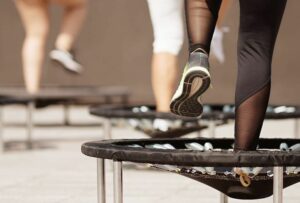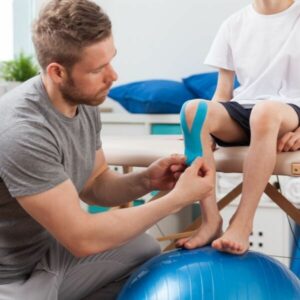Rebound physical therapy is a cutting-edge approach to healing that is gaining in popularity. This type of therapy uses a trampoline to help patients recover from injuries or surgeries. There are many benefits to using this type of therapy, including improved circulation, increased range of motion, and better overall fitness. In this blog post, we will discuss the basics of rebound physical therapy and how it can help you recover from your injury!
Contents
What Is Rebounding In Physical Therapy?
 Rebounding in physical therapy is an innovative approach to healing that offers a variety of benefits. It uses low-impact exercises on a trampoline or mini-trampoline to create fast, efficient and effective results. This type of physical therapy can help people recover from injury, surgery or illness more quickly than traditional methods by reducing pain and improving range of motion. It can also reduce stress and improve overall physical fitness by increasing flexibility, muscle strength, coordination and balance.
Rebounding in physical therapy is an innovative approach to healing that offers a variety of benefits. It uses low-impact exercises on a trampoline or mini-trampoline to create fast, efficient and effective results. This type of physical therapy can help people recover from injury, surgery or illness more quickly than traditional methods by reducing pain and improving range of motion. It can also reduce stress and improve overall physical fitness by increasing flexibility, muscle strength, coordination and balance.
Rebounding provides a low-impact workout while still providing the same benefits as a traditional high-intensity exercise routine. The exercises are more comfortable because they do not involve any impact on joints or bones—instead, the patient is gently supported and the body is allowed to move freely. The exercises are also very efficient, as they can be done in a short amount of time with minimal effort. Additionally, because the trampoline absorbs some of the impact, it reduces joint stress and is beneficial for those suffering from arthritis or other chronic pain conditions.
What Are The Types Of Rebound Physical Therapy?
Rebound physical therapy is an innovative form of rehabilitation and healing that has rapidly gained popularity in recent years. It combines traditional physical therapy techniques with the use of an inflatable, air-filled rebounder device which allows for low-impact exercises. This particular therapy can offer a wide range of benefits, from increased flexibility to improved balance and coordination. It can be used to treat a variety of conditions, from lower back pain to athletic injuries and chronic pain syndromes.
Types of rebound physical therapy include:
Standard Rebounding
This type of therapy involves patients jumping on the inflatable device in order to stretch and strengthen muscles, improve balance, and increase flexibility. Exercises are performed in a controlled manner, so as not to cause injury or strain.
Strength and Balance Training
This type of rebound physical therapy also involves bouncing on the inflatable device, but with more emphasis placed on core strength and balance exercises. Patients will typically perform squats, lunges, and other strengthening exercises while standing on the device.
Athletic Training

Rebound physical therapy can also be used to help athletes improve their performance and reduce injury risk. Exercises such as joint rotations, jump squats, and plyometric drills can all be performed on the rebounder to help increase strength, power, and agility.
Rehabilitation
Rebound physical therapy can also be used in rehabilitation following an injury or surgical procedure. Specialized exercises are designed to help patients regain range of motion, strength, and stability after an injury.
Rebound physical therapy offers a wide range of benefits for individuals seeking healing and recovery from various conditions. It is a safe, low-impact form of exercise that is suitable for people of all ages and fitness levels. If you are looking to improve your physical health, increase flexibility, or rehabilitate an injury, this therapy may be the right choice for you. Talk to a medical professional today to learn more about how this innovative form of therapy could help you reach your goals.
What Are The Benefits Of Rebound Physical Therapy?
 Rebound physical therapy is an innovative approach to healing that uses the principles of physics and biomechanics for treating musculoskeletal conditions. It is based on years of research into how the body works and often acts as a bridge between physical therapy and rehabilitation treatments. Rebound physical therapy can help reduce pain, improve mobility, increase strength and endurance, and improve posture.
Rebound physical therapy is an innovative approach to healing that uses the principles of physics and biomechanics for treating musculoskeletal conditions. It is based on years of research into how the body works and often acts as a bridge between physical therapy and rehabilitation treatments. Rebound physical therapy can help reduce pain, improve mobility, increase strength and endurance, and improve posture.
The main benefits of rebound physical therapy include:
Improved Mobility: Rebound physical therapy can help improve range of motion, strength, and flexibility. It also helps to correct misalignments in the body which can reduce pain and aid in healing.
Relief from Pain: This therapy helps to relieve pain by relaxing muscles and allowing them to move more freely. It can also encourage the body to release endorphins, which are natural pain-relieving chemicals in the body.
Improved Posture: This therapy helps improve posture by helping to strengthen muscles and improve coordination. This can make it easier to keep proper alignment while standing or sitting and help reduce lower back pain.
Improved Quality of Life: Rebound physical therapy can help improve the overall quality of life by providing relief from pain, improving mobility, and helping to correct poor postural habits. This can even lead to increased confidence when engaging in daily activities.
Rebound physical therapy is an innovative approach to healing that has been used successfully for decades. It can provide relief from pain, improve mobility, and help to correct poor postural habits. If you are looking for a safe and effective way to reduce pain, improve function, and promote overall health, then consider trying this therapy. It may be the answer you’ve been seeking.
How Long Should You Wait to Rebound?
 When it comes to physical therapy, one question many people ask is how long they should wait before rebounding. The answer depends on the type of injury and the severity of the injury. Generally speaking, it’s important to wait until your body has fully healed from its injury before you begin a rebound physical therapy program. Depending on the nature of your injury, that could be anywhere from a few days to several weeks.
When it comes to physical therapy, one question many people ask is how long they should wait before rebounding. The answer depends on the type of injury and the severity of the injury. Generally speaking, it’s important to wait until your body has fully healed from its injury before you begin a rebound physical therapy program. Depending on the nature of your injury, that could be anywhere from a few days to several weeks.
Rebound physical therapy is a comprehensive approach to rehabilitation, combining traditional physical therapy techniques with newer methods such as Pilates and yoga. It focuses on strengthening core muscles while restoring flexibility and range of motion in injured areas. The goal is to restore balance and function to the body, rather than just treating a single injury.
Rebound physical therapy is beneficial for both long-term injuries as well as acute injuries. It can be used in conjunction with traditional physical therapy techniques or on its own. In addition to helping you recover from an injury, this therapy can also help to prevent future injuries by strengthening the muscles around a joint or body part.
When it comes to getting back into physical activity after an injury, rebound physical therapy can be a great way to ease your body back into regular exercise. It is important to ensure that you are regularly performing exercises correctly under the supervision of an experienced physical therapist. This will help you to reduce the risk of further injury and help you to get back into regular activity as quickly and safely as possible.
Overall, rebound physical therapy is an innovative approach to healing that can aid in recovery from both acute and chronic injuries. It is important to remember that when it comes to recovering from an injury, patience is key.
Conclusion
In conclusion, rebound physical therapy is a revolutionary approach to healing that offers many advantages over traditional physical therapy. It is an effective and efficient way to improve strength, balance, coordination, flexibility, posture and overall health. With its innovative exercises, tools and techniques designed to target specific problem areas, this therapy can be used as a comprehensive form of rehabilitation. It can also be used as an individualized treatment plan tailored to meet the specific needs of the patient. This therapy offers a safe, non-invasive approach to restoring physical health and well-being, making it an ideal choice for those seeking an alternative form of care. If you’re looking for an innovative way to take charge of your own health and healing, look no further than rebound physical therapy.
Physical Therapy help patients recover from pain. If you’re experiencing Back pain, Shoulder pain, Knee pain, Neck pain, Elbow pain, Hip pain, or Arthritis pain, a physical therapist at MantraCare can help: Book a physiotherapy session.


